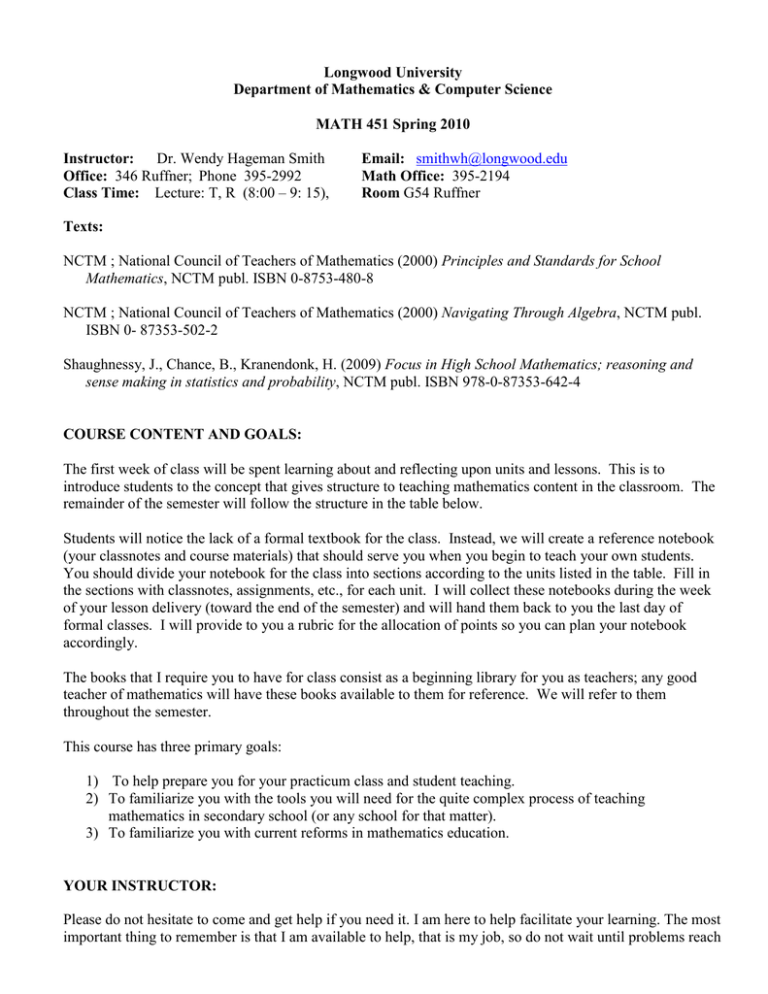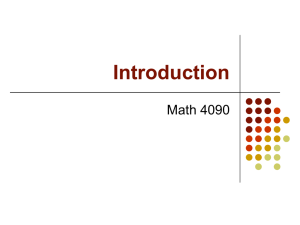MATH 451
advertisement

Longwood University Department of Mathematics & Computer Science MATH 451 Spring 2010 Instructor: Dr. Wendy Hageman Smith Office: 346 Ruffner; Phone 395-2992 Class Time: Lecture: T, R (8:00 – 9: 15), Email: smithwh@longwood.edu Math Office: 395-2194 Room G54 Ruffner Texts: NCTM ; National Council of Teachers of Mathematics (2000) Principles and Standards for School Mathematics, NCTM publ. ISBN 0-8753-480-8 NCTM ; National Council of Teachers of Mathematics (2000) Navigating Through Algebra, NCTM publ. ISBN 0- 87353-502-2 Shaughnessy, J., Chance, B., Kranendonk, H. (2009) Focus in High School Mathematics; reasoning and sense making in statistics and probability, NCTM publ. ISBN 978-0-87353-642-4 COURSE CONTENT AND GOALS: The first week of class will be spent learning about and reflecting upon units and lessons. This is to introduce students to the concept that gives structure to teaching mathematics content in the classroom. The remainder of the semester will follow the structure in the table below. Students will notice the lack of a formal textbook for the class. Instead, we will create a reference notebook (your classnotes and course materials) that should serve you when you begin to teach your own students. You should divide your notebook for the class into sections according to the units listed in the table. Fill in the sections with classnotes, assignments, etc., for each unit. I will collect these notebooks during the week of your lesson delivery (toward the end of the semester) and will hand them back to you the last day of formal classes. I will provide to you a rubric for the allocation of points so you can plan your notebook accordingly. The books that I require you to have for class consist as a beginning library for you as teachers; any good teacher of mathematics will have these books available to them for reference. We will refer to them throughout the semester. This course has three primary goals: 1) To help prepare you for your practicum class and student teaching. 2) To familiarize you with the tools you will need for the quite complex process of teaching mathematics in secondary school (or any school for that matter). 3) To familiarize you with current reforms in mathematics education. YOUR INSTRUCTOR: Please do not hesitate to come and get help if you need it. I am here to help facilitate your learning. The most important thing to remember is that I am available to help, that is my job, so do not wait until problems reach critical mass. He who hesitates is lost, so don't hesitate. You are responsible for everything that happens in class. I am of course willing to help you, but I am not willing to re-teach the course in my office. If you miss class, get the notes from someone and then come get help. If you have specific physical, psychiatric, or learning disabilities and require accommodations, please let me know early in the semester so that your learning needs may be appropriately met. You will need to provide documentation of your disability to the Disability Services Office. YOUR GRADE: Your grade for the class will be figured on in-class assignments, homework, quizzes/tests, a unit plan, the PraxisII test, a portfolio, your notebook, and the delivery of a half-hour lesson. In the “General Grading Overview” section on this syllabus is a breakdown of how grades are decided. Rubrics will be provided for the unit plan, class notebook, portfolio, and the lesson. In-class work: There will often be in-class work. You can only get one of two scores on in-class work: one point for having made a serious attempt to do it, or zero. You will be doing in-class assignments for just about every class. Homework: Homework assignments are 10 points each. Quizzes: Quizzes will be given weekly and will be on material from the previous class sessions. In-class work, homework, and quizzes constitute 10% of your grade. Tests: There will be two tests for this course according to the schedule below. I will provide to you a review sheet prior to each test. Tests constitute 20% of your grade. Class notebook: In lieu of a formal textbook for this class, I think that having a quick reference, that contains nothing but the essentials, will be more convenient for you to use when you are out in the field teaching. Your notebook should contain ALL the work you do for the class, including class notes, divided up into sections (as per units) as outlined in the schedule below. I will provide to you a rubric for my grading scheme for the notebook. You will hand the notebook into me the day you deliver your lesson and I will hand it back to you the next class meeting day. Those of you who will be delivering your lesson on the scheduled day of the final will hand your notebook to me the last day of classes and I will return it to you the Monday of finals week. Your notebook constitutes 10% of your grade. Portfolio: You will create a portfolio for the class. I will be passing out the requirements for this the third week of class along with a rubric for the criteria on which I will grade it. The portfolio constitutes 10% of your grade. Unit Plan: You will submit a unit plan for the class. I will provide the particular and the rubric for the unit plan when you take your first test. The unit plan is due the week of your second test and constitutes 10% of your grade. Praxis Test: You are required to take the PraxisII the week of spring break. Check the ETS website for places where the test will be offered that week. Your grade will be figured on simply taking the test and then submitting your scores for the test. Taking the Praxis will fulfill 20% of your grade. Final: For the final in this class, you will deliver a 30 minute lesson on a topic I will provide to you after spring break. The last two days of class and the day reserved for your final will allow enough time for everyone in the class to deliver their lesson. I will make a video of your lesson so we can go over it together in my office. The final counts as 20% of your grade. General Grading Overview Course Grades will be calculated using a 10 point scale as follows: A = 90 ~ 100 B = 80 ~ 90 C = 70 ~ 80 D = 60 ~ 70 F = 0 ~ 60 Plus and minus grades are given at the discretion of the instructor. In general, the achievement of a student in a course indicates the following: A: Superior work B: Above average work C: Average work D: Below average I’m sure you have all seen this scaling and description before, but what does it mean? I will award a grade of A only to a student who meets every standard of learning in the course, and who in addition consistently exhibits excellence in their work. Absent consistent excellence, I award a B to the student who meets every standard. I award a C to the student who has met most of the standards of learning, but continues to struggle in acquiring some key skills or concepts. I award a grade of D to a student who is capable but appears, based on their performance and effort, unable to commit themselves to achieving a minimum acceptable standard. I reserve a failing grade only for those students who do not meet minimum standards of learning, and who seem unable to do so at the level of the course. This indicates that the student must, if he or she is to continue to pursue the same educational goals, be prepared to repeat coursework and – most critical – thoughtfully reexamine their goals and priorities with an eye towards reinventing themselves as a student. ADDITIONAL INFORMATION Students are responsible for checking the ANNOUNCEMENTS in Blackboard in advance of each class period as there will be important information regarding assignments, due dates, items that must be brought to the next class session, etc. Also, students are responsible for downloading all needed course documents from Blackboard, printing them if hardcopies are desired, and knowing the information contained therein. Class Attendance As implied above in course content and goals and in the in-class assignments sections, students are required to attend all classes. Due to the nature of this course, participation in activities and discussion is vital to learning content and methods. Thus, missing class will hurt your opportunity to succeed! The following attendance policies are in effect for this course: A grade of “0” or “F” may be given on work missed because of unexcused absences A course grade of “F” may be assigned when the student has missed a total (excused and unexcused) of 25 percent of the scheduled class meeting times (more than 5 absences) Acceptable excused absences (as listed in the Longwood catalog) will be taken into consideration for missed tests; however, except in VERY EXTREME circumstances, be sure to make PRIOR arrangements. Longwood’s Honor System A strong tradition of honor is fundamental to the quality of living and learning in the Longwood community. The Honor System was founded in 1910, and its purpose is to create and sustain a community in which all persons are treated with trust, respect, and dignity. Longwood affirms the value and necessity of integrity in all intellectual community endeavors. Students are expected to assume full responsibility for their actions and to refrain from lying, cheating, stealing, and plagiarism. The Longwood Honor Code applies to all work for the course as follows: Any out-of-class practice work or hand-in assignment can include using text information, discussion with other class members, and/or discussion with instructor BUT, the final product handed-in for the grade must be the student’s own work. Any in-class activities that involve teamwork allows for discussion within your team as directed by the instructor. All tests are to be completed individually (unless otherwise noted in directions from instructor). Please sign the honor code on all exams indicating that: “I have neither given nor received help on this work, nor am I aware of any infraction of the Honor Code.” Schedule Outline Week Unit Jan 12-14 Introduction Jan 19-20 Mathematics as a process Jan 26-28 Feb 2 - 4 Topics Reading Doing Mathematics Read NCTM Standards pp. 29-71 Read NCTM Standards pp. 11-27 Learning Theories Mathematics Curriculum NCTM and Virginia SOLs Feb 9 - 11 Traditional and Integrated Curriculums Read Navigating Through Algebra pp. 1-5 Feb 16-18 Writing a Lesson Test 1 Feb 23-25 Teaching Mathematics March 2-4 Mar 8 - 11 Mar 16-18 Assessment Mar 23-25 Purpose/Strategies Unit Plan Due Test 2 Diversity Apr 13-15 Lessons Apr 20-22 Apr 26-30 Spring Break – no classes Principles Mar 30 – April 1 Apr 6-8 Writing Goals and Objectives Teaching Tools/Strategies Take Praxis2 on the 13th See ETS website for places Finals Week Lessons Portfolio due TBD

